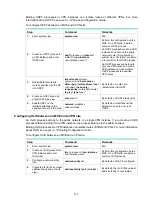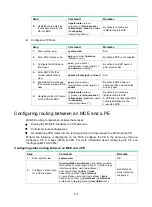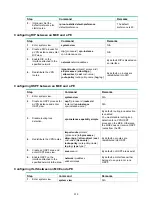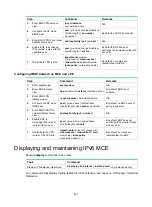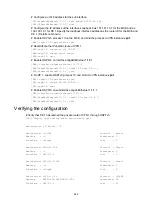
529
Step Command
Remarks
3.
Associate a VPN instance
with the interface.
ip binding vpn-instance
vpn-instance-name
By default, an interface is not
associated with a VPN instance
and belongs to the public network.
The
ip binding vpn-instance
command clears the IP address of
the interface. Therefore,
reconfigure an IP address for the
interface after configuring this
command.
Configuring route related attributes for a VPN instance
Step Command
Remarks
1.
Enter system view.
system-view
N/A
2.
Enter VPN instance view or
IPv6 VPN view.
•
Enter VPN instance view:
ip vpn-instance
vpn-instance-name
•
Enter IPv6 VPN view:
a. ip vpn-instance
vpn-instance-name
b. address-family ipv6
Configurations made in VPN
instance view apply to both IPv4
VPN and IPv6 VPN.
IPv6 VPN prefers the
configurations in IPv6 VPN view
over the configurations in VPN
instance view.
3.
Configure route targets.
vpn-target
vpn-target
&<1-8>
[
both
|
export-extcommunity
|
import-extcommunity
]
By default, no route targets are
configured.
4.
Set the maximum number of
active routes.
routing-table
limit
number
{
warn-threshold
|
simply-alert
}
By default, the maximum number
of active routes is 500100.
Setting the maximum number of
active routes for a VPN instance
can prevent the PE from storing
too many routes.
5.
Apply an import routing
policy.
import route-policy
route-policy
By default, all routes matching the
import target attribute are
accepted.
Make sure the routing policy
already exists. Otherwise, the
device does not filter received
routes.
For information about routing
policies, see
Layer 3—IP
Routing
Configuration Guide.
6.
Apply an export routing
policy.
export route-policy
route-policy
By default, routes to be advertised
are not filtered.
Make sure the routing policy
already exists. Otherwise, the
device does not filter routes to be
advertised.
For information about routing
policies, see
Layer 3—IP
Routing
Configuration Guide.

